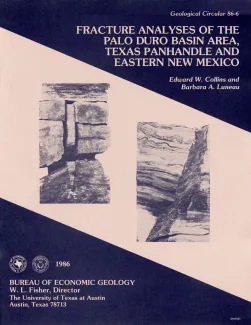
Publication Details
Geolocation:
Get the Publication
$9.00
Abstract/Description:
Fractures and veins in strata of the Palo Duro Basin area, Texas Panhandle and eastern New Mexico, are characterized using data from outcrop and core studies and from fracture identification log analysis. Fractures are associated with faults and folds that occur along the margins of the Palo Duro Basin and in relatively undeformed strata within the central basin area. Along the Amarillo Uplift, strikes of fractures in Permian and Triassic rocks differ from fracture orientations in overlying Tertiary strata. Fracture orientations determined by fracture identification logs from wells in Deaf Smith and Swisher Counties indicate that fracture strikes in Pennsylvanian and Permian strata are similar. Throughout the region, fractures that strike east-west (275°-295°) and northwest-southeast (305°-320°) are the most common. Zones of closely spaced fractures occur in outcropping Permian and Triassic strata. The width of the joint zones may be as great as 40 m, and the zones may extend laterally 0.75 km or possibly farther. Gypsum veins commonly occur in strata that have undergone collapse following salt dissolution, whereas halite veins cut salt-bearing strata. Although a subpolygonal pattern on bedding planes suggests a synsedimentary origin for some of the halite veins, a variety of crosscutting relationships indicate that many of the halite veins had postcompactional origins.